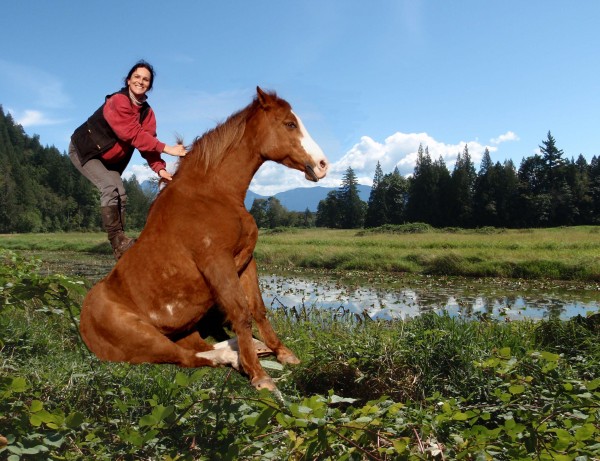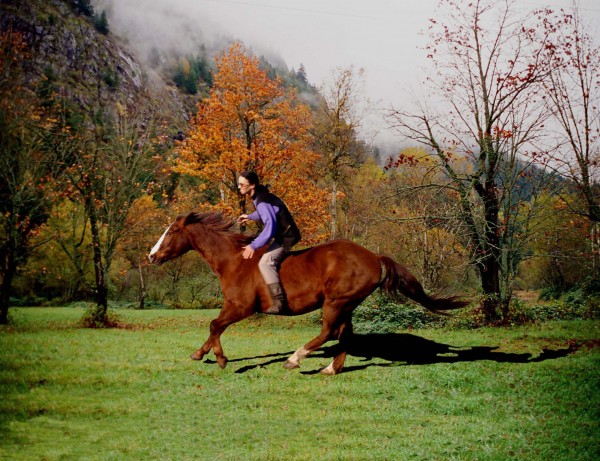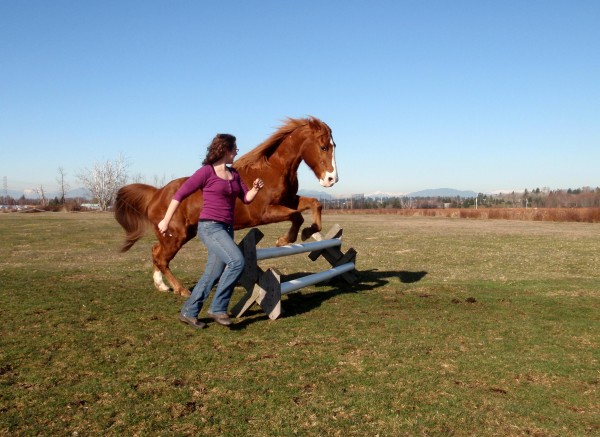How to H.E.M – Help, Explain and Motivate your horse
|
|
Helfen, Erklären und Motivieren
|
- What you need to know for honest play
- The Ten Laws of Shaping
- Working with positive reinforcement
- PLAYING with horses – my niche in the horse world – is not the same as working your horses, although it is of course a form of training. Real play excludes any form of pressure, coercion, punishment, stress or demand for obedience. It is a dialogue, where we all participate with voluntary cooperation and fun. We address the horses’ understanding – we don’t only train their muscles (though many of our games are very beneficial for that!) but first and foremost their brain.
- We love our horses, and working with positive reinforcement sounds simple. But the simplest game can become devilishly difficult, when the horse had previous bad experiences, which he associates with parts of your proposed games: fears of whips or ropes, if he has previously been beaten or tied. To understand what we mean by voluntary, picture training a Grizzly bear (where it would be advisable to no apply the minutest pressure!), who does not wear a halter (on which you wouldn’t dare to pull anyway, if you wanted to survive!) in a wide open field – a bear, who further-more is more interested in eating than in playing with you! Trainers of bears know, why they only work with positive reinforcement!
|
|
- Was man zum echten Spielen wissen muss
- Die Zehn Gebote des Formens
- Arbeit mit Positiver Verstärkung
- Mit Pferden SPIELEN – meine Nische in der Pferdewelt – ist nicht das selbe wie arbeiten, obwohl es natürlich auch Training ist. Echtes Spiel schließt jede Form von Druck, Zwang, Bestrafung, Stress oder Bestehen auf Gehorsam aus. Es ist ein Dialog, an dem wir alle freiwillig und mit Vergnügen teilhaben. Wir sprechen den Verstand der Pferde an – wir trainieren nicht nur ihre Muskeln (obwohl viele unserer Spiele hierfür sehr vorteilhaft sind!), sondern wenden uns vor allem an ihr Gehirn.
- Wir lieben unsere Pferde, und Arbeiten mit positiver Verstärkung klingt einfach. Aber das einfachste Spiel kann schon teuflisch schwierig werden, wenn das Pferd mit Teilen der vorgeschlagenen Übung schlechte Erfahrungen gemacht hat – wenn es Angst vor der Peitsche oder Seilen hat, da es geschlagen oder gefesselt wurde. Um zu begreifen was wir unter freiwillig verstehen, stellen Sie sich vor, daß Ihr Pferd ein Grizzly wäre (wo man besser nicht mal den leichtesten Druck ausüben sollte!), der kein Halfter anhat (an dem man sowieso nicht ziehen würde, wenn einem das Leben lieb ist!) und das alles auf weitem Feld – ein Tier, das dazu noch lieber fressen will an statt zu spielen! Bärentrainer wissen, warum sie nur mit positiver Verstärkung arbeiten!
|
|
|
- If you wish to build a relationship with your new partner in a playful way, then you have to do a bit of homework. A horse will not stick around you and will not voluntarily react to your proposals without a good reason. To convince him to do so, you must learn to become a better leader, a better helper, a better partner, a better friend, a better trainer and a better motivator.
|
|
- Wenn Sie mit Ihrem neuen Partner spielerisch eine Beziehung aufbauen wollen, dann gehören ein paar Hausaufgaben dazu. Denn ein Pferd wird nicht ohne Grund bei Ihnen bleiben und auf Ihre Vorschläge eingehen. Um es dazu zu überreden muß man lernen besser zu werden: ein besserer Anführer, ein besserer Helfer, ein besserer Partner, ein besserer Freund, ein besserer Trainer und ‚Motivator‘.
|
|

|
- How to create a good relationship, develop leadership qualities, establish respect and learn correct principles of training is explained in greater length in my book (“From Leading to Liberty”), and would here go beyond the scope of these articles. Although the back stretch shown in this picture feels good, a horse will only remain quietly in a sitting position, while you clamber around on him, if he respects and trusts you fully.
|
|
- Wie man diese gute Beziehung aufbaut und diese Führungsqualitäten erwirbt, wie man Respekt erreicht und gute Trainingsprinzipien erlernt, ist alles ausführlicher in meinem Buch („From Leading to Liberty“) beschrieben und würde den Rahmen dieser Artikel sprengen. Obwohl sich die Rückendehnung gut anfühlt, wird ein Pferd, wie hier im Bild, nur ruhig in der Sitz- Position verharren, während Sie auf ihm herum turnen, wenn es Sie respektiert und Ihnen voll vertraut.
|
 Willing, reliable and fast! Peter was a joy to ride! |
- It is important to understand that we do not “whisper”, but base our training on scientific research and principles.
- Nothing will be effective as well as enjoyable to the horse, if you don’t follow the Ten Laws of Shaping.
Learn to internalise these important laws! Read on in the next series!
|
|
- Es ist wichtig zu verstehen, daß wir nicht „flüstern“, sondern unser Training auf wissenschaftliche Untersuchungen und Prinzipien aufbauen.
- Nichts wird effektiv und gleichfalls erfreulich für das Pferd sein, wenn es nicht auf den Zehn Geboten des Formens basiert.
Lernen Sie diese wichtigen zehn Gebote zu verinnerlichen – lesen Sie im nächsten Teil dieser Serie weiter!
|
|
|
|
|
|
|
|
|




